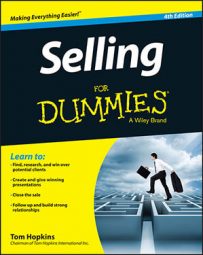To be successful at selling, you must be constantly on the prowl for information. What type of information? Everything and anything about your product, your company, your competition, and (most importantly) your prospect. And with the Internet just a mouse click away, you really have no excuse for not being well informed. An abundance of information is available, quite literally, at your fingertips.
All you need is the commitment to locate and internalize it. Never forget: Knowledge is power.
The most important thing to remember when you’re selling is the benefit of being able to walk in someone else’s shoes. You can’t be of any help to a prospective client with what you’re offering her until you truly understand what she needs and where she’s coming from.
So where do you begin in your quest to walk in your prospects’ shoes? Not at the shoe store. Instead, you need to do some basic research into your prospective clients, their businesses, and their goals. Start by following these tips:
Visit the business’s website and social media pages. Pay particular attention to the business’s online product catalog (if there is one), and look for press releases posted on the site so you’re up‐to‐date on the most recent news related to the business. Plus, always look for “About Us” and “Executive Summary” links on the website. The information you find there often gives you valuable insight into the management team and their backgrounds. And who knows? You may find out that you know someone who works there or that you know someone who knows someone there.
Take advantage of services such as Google alerts. Google allows you to request information posted about specific topics or companies . . . and to have those alerts sent to you via email.
Get copies of the company’s product brochures and/or catalogs. Talk with one of its customer service representatives about what the company offers. If you’re familiar with the products that your prospective client sells, you’re better able to sell her your product.
Look up past news articles on the business or its industry. If you’re familiar with what’s been happening in the industry in the past few months, you can work that information into your conversations with the people who work in it. The prospect will get the sense that you’ve done your homework about her — so you’ve probably done your homework about your own products, too. And that’s exactly the impression you want to make.
Check out the business’s financial report, if it’s available. Get the names of the company president and other key people — and find out how to pronounce and spell their names. For the pronunciation, simply call the company and ask the receptionist for that information.
If your prospective clients are individuals or families (the consumer sale), you need to gather information in a less formal manner. If you’re learning about someone by referral, ask as many questions about her as you can without seeming overly zealous or intrusive.
You can certainly ask for her contact information, including where she lives, how the referrer knows her (through their kids’ school, church, another social venue, and so on), and what brought these folks to mind. It could very well be that the last time these people spoke, the subject of getting a new car or having the house painted came up.
Leave no paperwork or link on a prospect unturned when you do your research. Your legwork will pay handsome dividends in the long run. Knowledge is power when it’s properly applied. And you should always apply that philosophy to research that helps you sell.
Although doing your research and gathering information about your prospective clients is essential, knowing when you have enough information is often difficult. In the end, it’s up to you, of course. When you think you know enough to get the job done and make the sale, you’ve probably researched enough. If a question comes up during your presentation that you don’t know the answer to, and if what you don’t know may hurt your chances of closing the sale, then you don’t know enough. Experience will tell you how much you need to prepare, but you’re better off erring on the side of preparing too much than not preparing enough.

